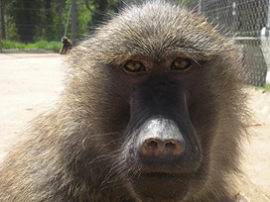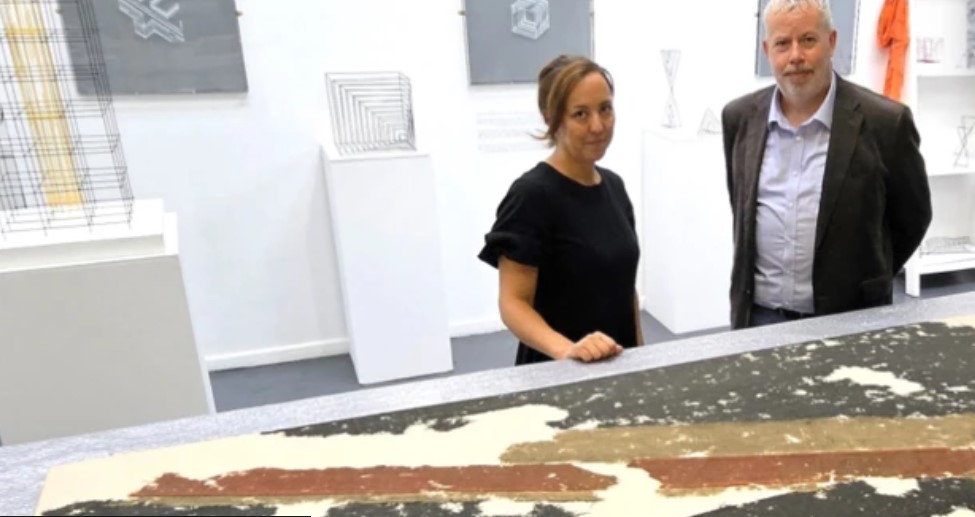
Female baboons use odour to manipulate male behaviour and advertise fertility to mates

A research project led by a University of Wolverhampton academic has found that olive baboons’ (Papio anubis) vaginal odour changes during their reproductive cycle, suggesting that smell plays a crucial role in signalling when they are at their most fertile.
The researchers propose that female baboons could use the change in scent to tackle a common dilemma that primates face. Females gain benefits, such as access to resources, protection and ‘good genes’, from giving the ‘best male’ a higher probability of paternity. However, they also benefit from confusing paternity to reduce the risk of infanticide; when offspring are killed intentionally by a new partner to make the female sexually receptive.
The ‘graded-signal’ hypothesis suggests that females solve this dilemma by advertising their openness to attract and mate with multiple males, and therefore confuse paternity, while at the same time favouring the chances of fatherhood towards preferred males by using different modes of signalling.
While a visual or acoustic signal is broadcast to all males present, only dominant males will be able to approach and smell a female’s genitalia. Therefore, an accurate indication of the probability of ovulation may only be available to dominant males.
Reader in Animal Behaviour Dr Stefano Vaglio from the University's School of Sciences said: “We tested the explanatory power of the ‘graded-signal’ hypothesis for olfactory signals for the first time.
"According to this hypothesis, dominant males tend to guard females only at peak swelling and, therefore, females would use vaginal odour signals to advertise the exact timing of ovulation only to preferred males who have close access to their genitalia during mate-guarding behaviour.
“Females thus manipulate male behaviour by altering the costs and benefits of mate-guarding, such that dominant males attempt to monopolise a female at the time when she is most likely to ovulate, while other males mate at sub-optimal times.”
There have been a number of studies of female characteristics around reproduction cycles, such as sexual swelling, behaviour and vocalisations, but odour communication has been neglected to this point. These findings contribute to improving understanding of how female non-human primates advertise their sexual receptivity.
As female olive baboons are an excellent model for comparison to women in terms of reproductive biology, this study is also pertinent to olfactory communication in humans.
Further work could resolve questions of interest for humans, such as whether and how olfaction is related to fertility, via detailed chemical analyses of odour secretions in different body regions across the menstrual cycle.
The paper Olfactory signals and fertility in olive baboons details the project results and has recently been published by Scientific Reports, an online peer-reviewed open access scientific mega journal published by Springer Nature.
Microsmatic primates revisited: Determining the importance of olfaction in primate communication (PrimOlf) was an EU-funded project awarded to Dr Vaglio while working as a Marie Curie post-doctoral fellow at Durham University. The research work took place at the University of Wolverhampton’s Rosalind Franklin laboratories.
For more information please contact the Corporate Communications Team.


/prod01/wlvacuk/media/departments/digital-content-and-communications/images-18-19/iStock-163641275.jpg)
/prod01/wlvacuk/media/departments/digital-content-and-communications/images-2024/250630-SciFest-1-group-photo-resized-800x450.png)
/prod01/wlvacuk/media/departments/digital-content-and-communications/images-2024/Judo.jpg)
/prod01/wlvacuk/media/departments/digital-content-and-communications/images-2024/Nikhil-Seth-honorary-professorship.jpg)
/prod01/wlvacuk/media/departments/digital-content-and-communications/submitted-news-images/St.-Kitts-and-Nevis-trip-web.jpg)
/prod01/wlvacuk/media/departments/digital-content-and-communications/images-2024/City-courtyard.jpg)
/prod01/wlvacuk/media/departments/digital-content-and-communications/images/Uni-teaser.png)

